Abstract
Strains of Vibrio cholerae, both O1 and non-O1 serovars, were found to attach to the surfaces of live copepods maintained in natural water samples collected from the Chesapeake Bay and Bangladesh environs. The specificity of attachment of V. cholerae to live copepods was confirmed by scanning electron microscopy, which revealed that the oral region and egg sac were the most heavily colonized areas of the copepods. In addition, survival of V. cholerae in water was extended in the presence of live copepods. Attachment of viable V. cholerae cells to copepods killed by exposure to -60 degrees C was not observed. Furthermore, survival of V. cholerae was not as long in the presence of dead copepods as in the live copepod system. A strain of Vibrio parahaemolyticus was also seen to attach to copepod surfaces without effect on survival of the organism in water. The attachment of vibrios to copepods was concluded to be significant since strains of other bacteria, including Pseudomonas sp. and Escherichia coli, did not adhere to live or dead copepods. Attachment of V. cholerae to live copepods is suggested to be an important factor of the ecology of this species in the aquatic environment, as well as in the epidemiology of cholera, for which V. cholerae serovar O1 is the causative agent.
Full text
PDF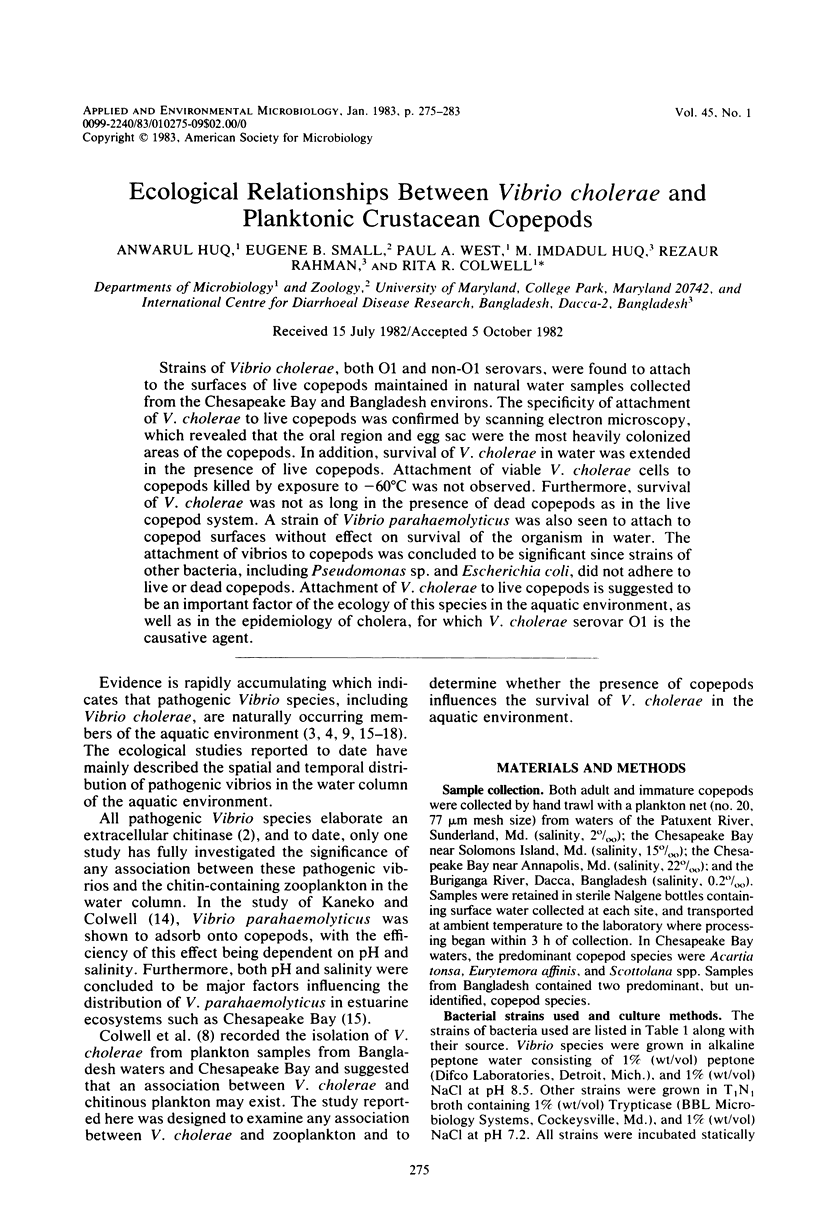
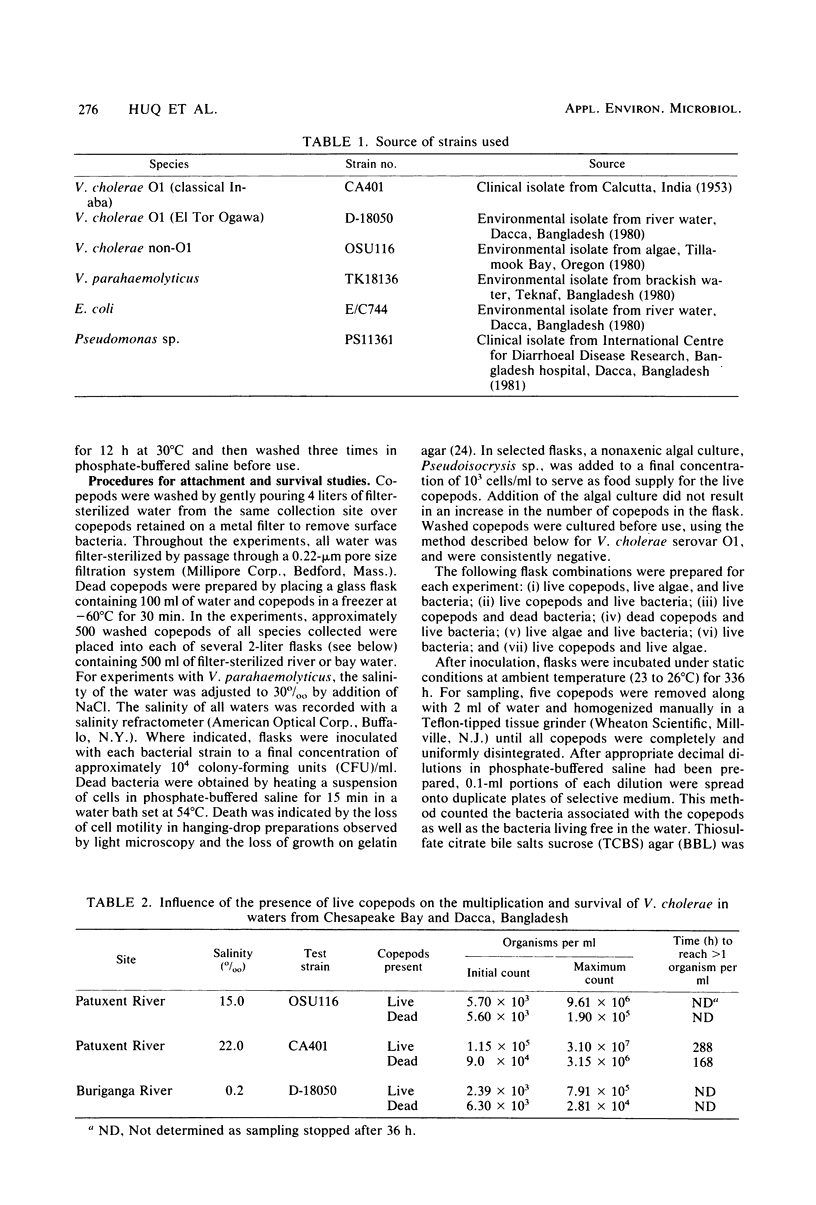
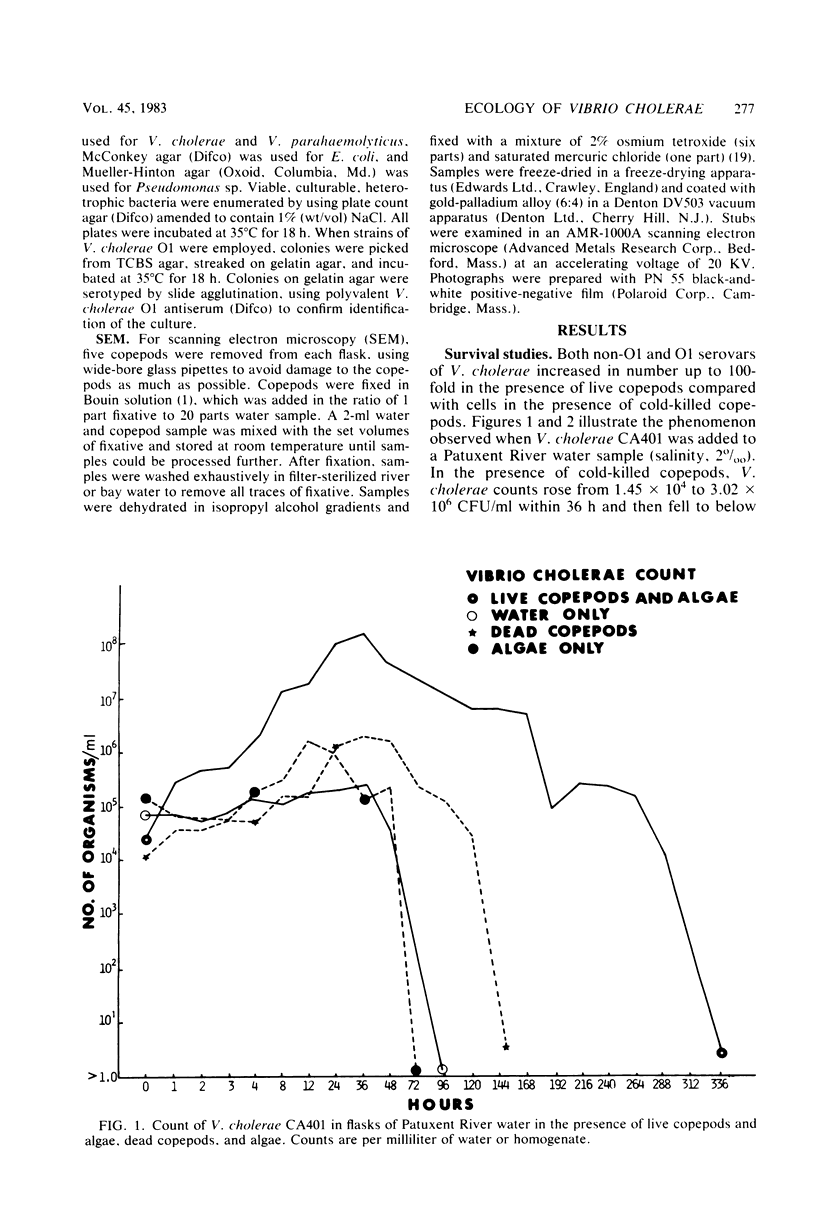

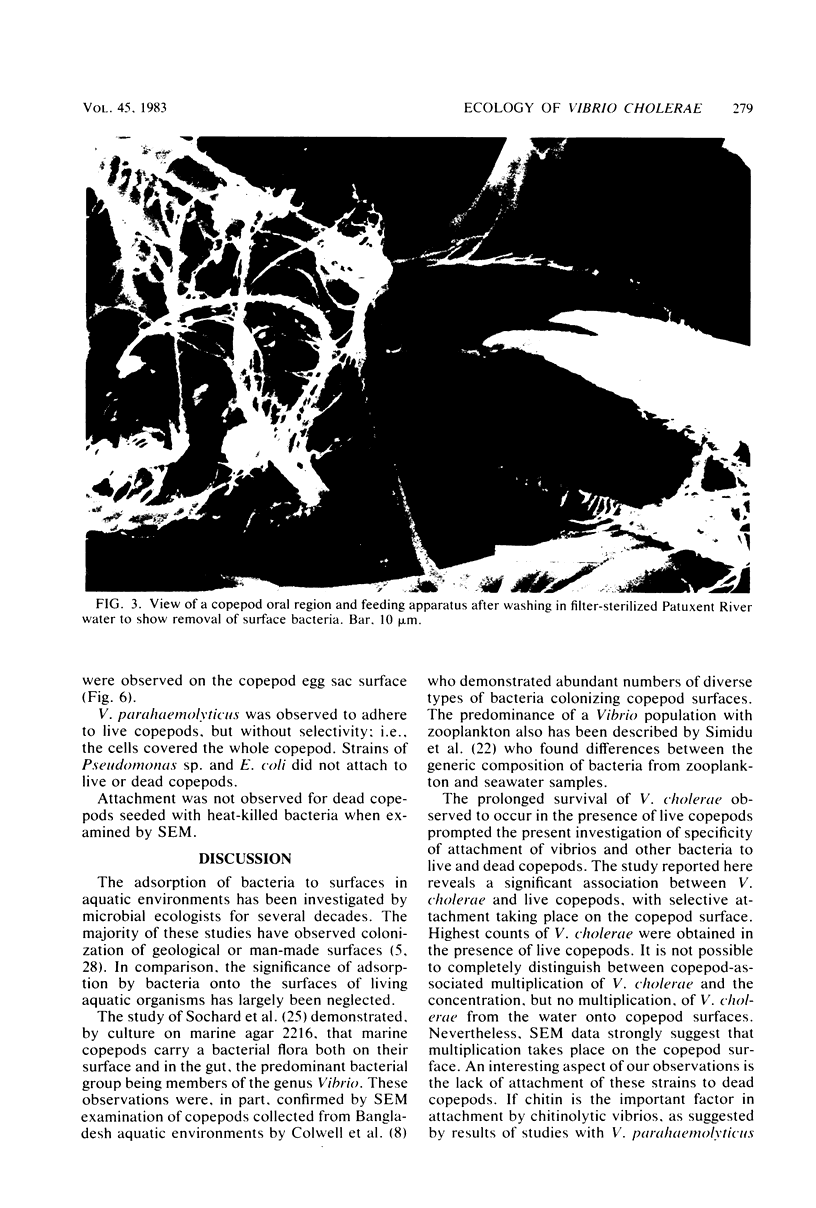
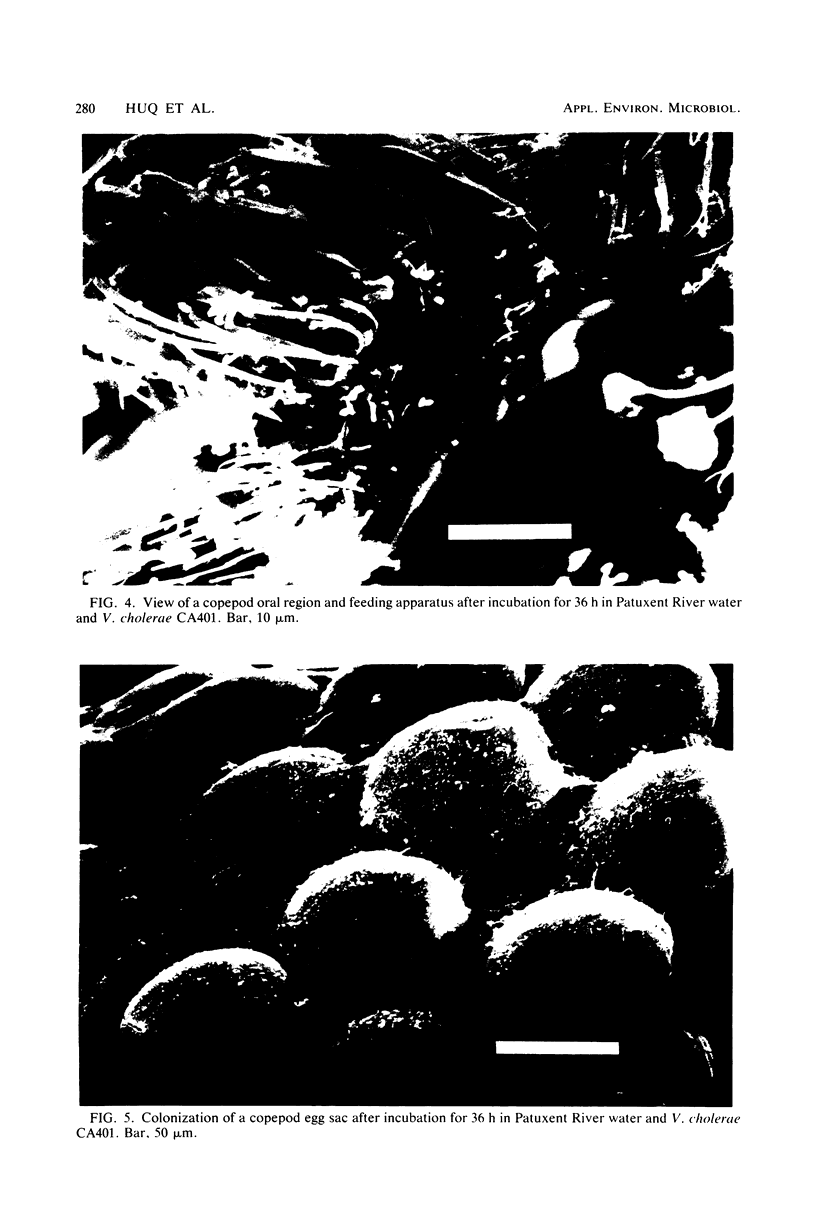
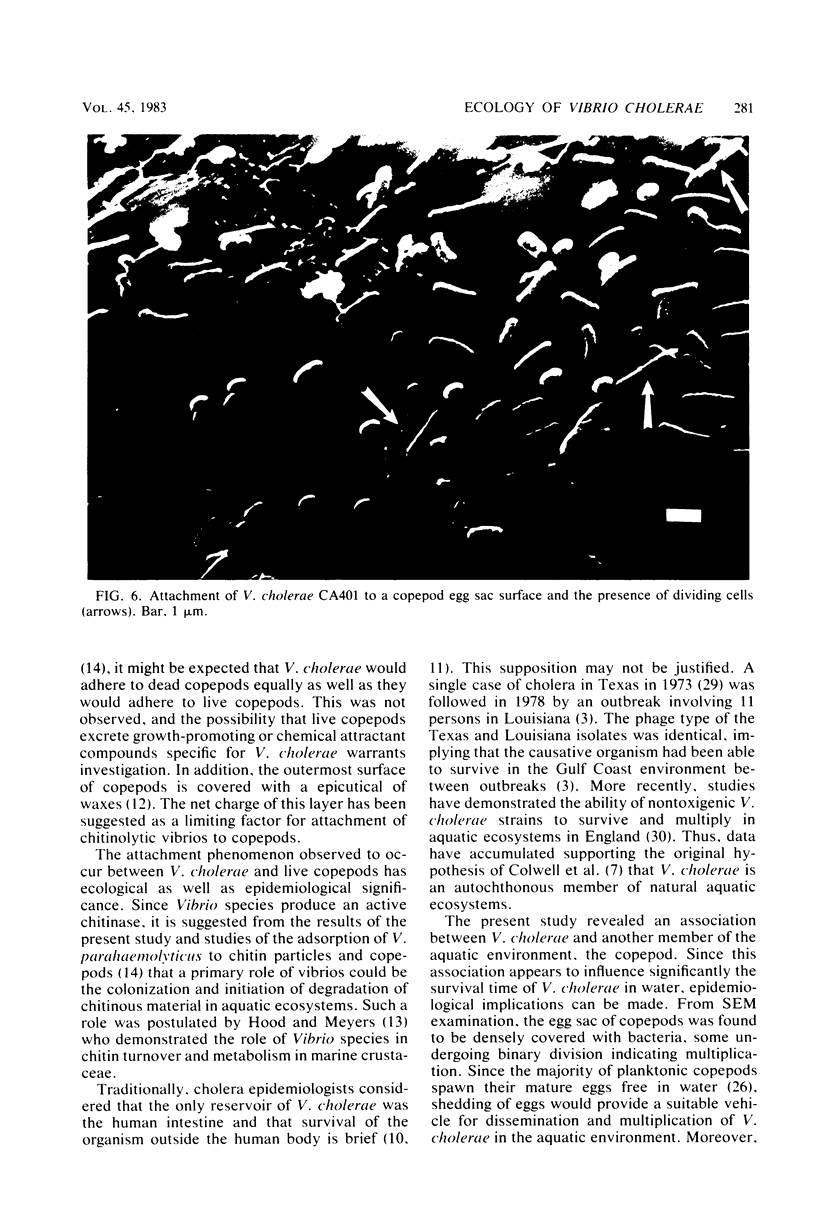
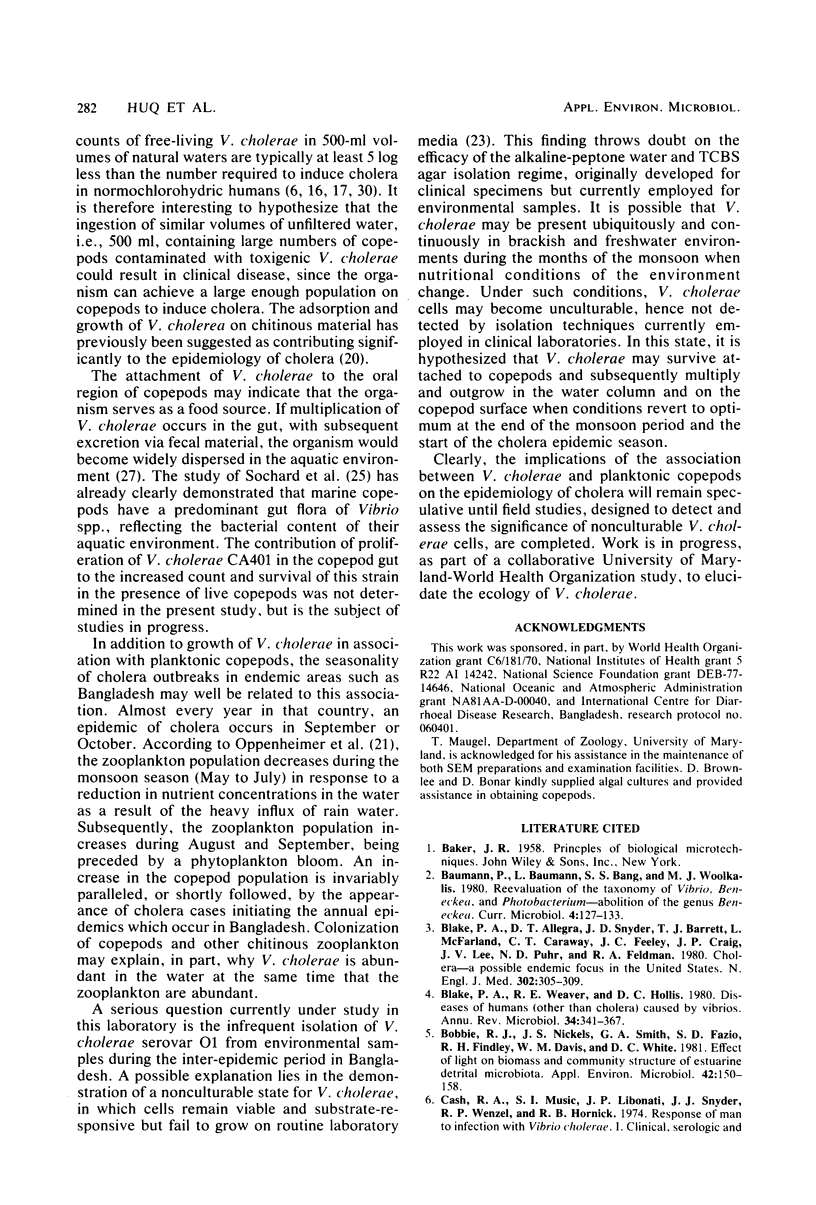

Images in this article
Selected References
These references are in PubMed. This may not be the complete list of references from this article.
- Blake P. A., Allegra D. T., Snyder J. D., Barrett T. J., McFarland L., Caraway C. T., Feeley J. C., Craig J. P., Lee J. V., Puhr N. D. Cholera--a possible endemic focus in the United States. N Engl J Med. 1980 Feb 7;302(6):305–309. doi: 10.1056/NEJM198002073020601. [DOI] [PubMed] [Google Scholar]
- Blake P. A., Weaver R. E., Hollis D. G. Diseases of humans (other than cholera) caused by vibrios. Annu Rev Microbiol. 1980;34:341–367. doi: 10.1146/annurev.mi.34.100180.002013. [DOI] [PubMed] [Google Scholar]
- Bobbie R. J., Nickels J. S., Smith G. A., Fazio S. D., Findlay R. H., Davis W. M., White D. C. Effect of light on biomass and community structure of estuarine detrital microbiota. Appl Environ Microbiol. 1981 Jul;42(1):150–158. doi: 10.1128/aem.42.1.150-158.1981. [DOI] [PMC free article] [PubMed] [Google Scholar]
- Cash R. A., Music S. I., Libonati J. P., Snyder M. J., Wenzel R. P., Hornick R. B. Response of man to infection with Vibrio cholerae. I. Clinical, serologic, and bacteriologic responses to a known inoculum. J Infect Dis. 1974 Jan;129(1):45–52. doi: 10.1093/infdis/129.1.45. [DOI] [PubMed] [Google Scholar]
- Colwell R. R., Kaper J., Joseph S. W. Vibrio cholerae, Vibrio parahaemolyticus, and other vibrios: occurrence and distribution in Chesapeake Bay. Science. 1977 Oct 28;198(4315):394–396. [PubMed] [Google Scholar]
- Colwell R. R., Seidler R. J., Kaper J., Joseph S. W., Garges S., Lockman H., Maneval D., Bradford H., Roberts N., Remmers E. Occurrence of Vibrio cholerae serotype O1 in Maryland and Louisiana estuaries. Appl Environ Microbiol. 1981 Feb;41(2):555–558. doi: 10.1128/aem.41.2.555-558.1981. [DOI] [PMC free article] [PubMed] [Google Scholar]
- Eyster C., Brown T. E., Tanner H. A., Hood S. L. Manganese Requirement with Respect to Growth, Hill Reaction and Photosynthesis. Plant Physiol. 1958 Jul;33(4):235–241. doi: 10.1104/pp.33.4.235. [DOI] [PMC free article] [PubMed] [Google Scholar]
- Felsenfeld O. A review of recent trends in cholera research and control. With an annex on the isolation and identification of cholera vibrios. Bull World Health Organ. 1966;34(2):161–195. [PMC free article] [PubMed] [Google Scholar]
- Kaneko T., Colwell R. R. Adsorption of Vibrio parahaemolyticus onto chitin and copepods. Appl Microbiol. 1975 Feb;29(2):269–274. doi: 10.1128/am.29.2.269-274.1975. [DOI] [PMC free article] [PubMed] [Google Scholar]
- Kaper J., Lockman H., Colwell R. R., Joseph S. W. Ecology, serology, and enterotoxin production of Vibrio cholerae in Chesapeake Bay. Appl Environ Microbiol. 1979 Jan;37(1):91–103. doi: 10.1128/aem.37.1.91-103.1979. [DOI] [PMC free article] [PubMed] [Google Scholar]
- Lee J. V., Bashford D. J., Donovan T. J., Furniss A. L., West P. A. The incidence of Vibrio cholerae in water, animals and birds in Kent, England. J Appl Bacteriol. 1982 Apr;52(2):281–291. doi: 10.1111/j.1365-2672.1982.tb04852.x. [DOI] [PubMed] [Google Scholar]
- Lee J. V., Shread P., Furniss A. L., Bryant T. N. Taxonomy and description of Vibrio fluvialis sp. nov. (synonym group F vibrios, group EF6). J Appl Bacteriol. 1981 Feb;50(1):73–94. doi: 10.1111/j.1365-2672.1981.tb00873.x. [DOI] [PubMed] [Google Scholar]
- Nalin D. R., Daya V., Reid A., Levine M. M., Cisneros L. Adsorption and growth of Vibrio cholerae on chitin. Infect Immun. 1979 Aug;25(2):768–770. doi: 10.1128/iai.25.2.768-770.1979. [DOI] [PMC free article] [PubMed] [Google Scholar]
- SMITH H. L., Jr, GOODNER K. Detection of bacterial gelatinases by gelatin-agar plate methods. J Bacteriol. 1958 Dec;76(6):662–665. doi: 10.1128/jb.76.6.662-665.1958. [DOI] [PMC free article] [PubMed] [Google Scholar]
- Simidu U., Ashino K., Kaneko E. Bacterial flora of phyto- and zoo-plankton in the inshore water of Japan. Can J Microbiol. 1971 Sep;17(9):1157–1160. doi: 10.1139/m71-184. [DOI] [PubMed] [Google Scholar]
- Singleton F. L., Attwell R., Jangi S., Colwell R. R. Effects of temperature and salinity on Vibrio cholerae growth. Appl Environ Microbiol. 1982 Nov;44(5):1047–1058. doi: 10.1128/aem.44.5.1047-1058.1982. [DOI] [PMC free article] [PubMed] [Google Scholar]
- Sochard M. R., Wilson D. F., Austin B., Colwell R. R. Bacteria associated with the surface and gut of marine copepods. Appl Environ Microbiol. 1979 Apr;37(4):750–759. doi: 10.1128/aem.37.4.750-759.1979. [DOI] [PMC free article] [PubMed] [Google Scholar]
- Weissman J. B., DeWitt W. E., Thompson J., Muchnick C. N., Portnoy B. L., Feeley J. C., Gangarosa E. J. A case of cholera in Texas, 1973. Am J Epidemiol. 1974 Dec;100(6):487–498. doi: 10.1093/oxfordjournals.aje.a112061. [DOI] [PubMed] [Google Scholar]
- West P. A., Lee J. V. Ecology of Vibrio species, including Vibrio cholerae, in natural waters in Kent, England. J Appl Bacteriol. 1982 Jun;52(3):435–448. doi: 10.1111/j.1365-2672.1982.tb05074.x. [DOI] [PubMed] [Google Scholar]






